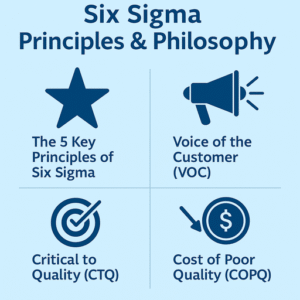Six Sigma is more than just a set of tools — it’s a way of thinking. In this module, we’ll explore the core principles and philosophies that drive Six Sigma projects across the world.

1. The 5 Key Principles of Six Sigma
These five principles are like the building blocks of every successful Six Sigma project:
-
Customer Focus:
Everything begins with the customer. Understand what they need, expect, and value the most.
Example: A hotel improves its room service speed because customer surveys showed delays caused dissatisfaction. -
Identify and Understand the Process:
Map your current process. Know exactly what’s happening at each step.
Example: A bank analyzes its loan approval process to find where delays occur. -
Reduce Variation and Eliminate Defects:
The goal is consistent, reliable output — every single time.
Example: A car manufacturer ensures that every engine passes the same performance test without exception. -
Involve and Equip People:
Train and empower employees to use data and make improvements.
Example: A call center trains staff in Six Sigma to reduce average call handling time. -
Continuous Improvement:
There is always room to get better — never settle.
Example: A software company runs weekly retrospectives to find and fix small inefficiencies in coding practices.
2. Voice of the Customer (VOC)
VOC means collecting and understanding what your customers truly want and expect — not just what you assume.
Sources of VOC:
-
Feedback forms
-
Online reviews
-
Direct interviews
-
Support calls
Example: An e-commerce company discovers through VOC that customers want same-day delivery — and they redesign logistics accordingly.
3. Critical to Quality (CTQ)
CTQs are the key measurable features that are essential to meet customer needs. They’re derived from VOC.
Example: If customers want faster internet speed, then “download speed” and “uptime” become CTQs for an internet provider.
CTQs are the bridge between customer expectations and internal process improvements.
4. Cost of Poor Quality (COPQ)
COPQ is the hidden cost you pay when quality is ignored. It includes:
-
Rework and scrap
-
Wasted time and material
-
Customer returns and refunds
-
Loss of reputation
Example: A mobile phone brand had to recall thousands of faulty devices. That’s COPQ — expensive and avoidable.


Leave a Reply